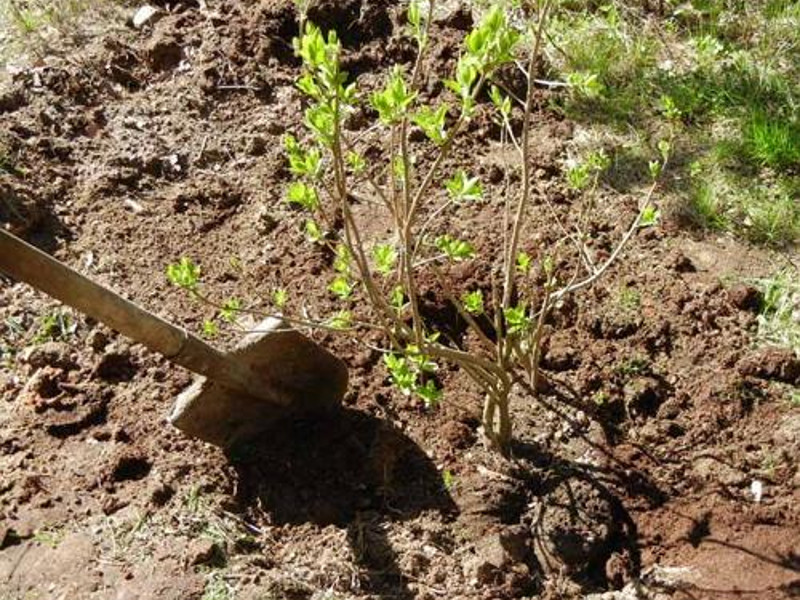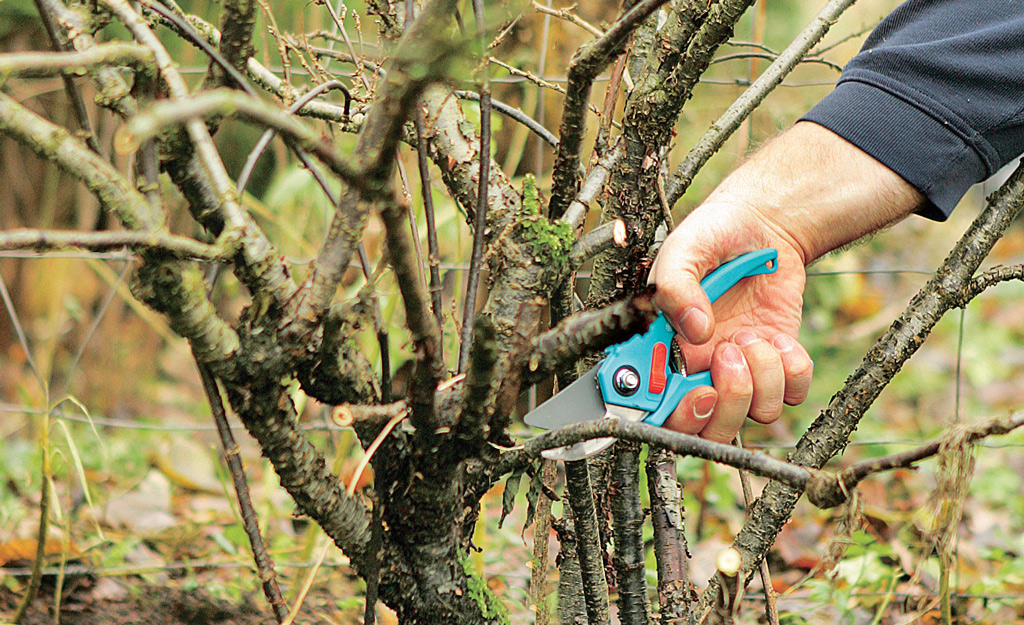During the planting of lilacs in autumn in the open ground, beginning gardeners may experience certain difficulties. Although young seedlings are less whimsical and quickly take root, nevertheless, one should not neglect the recommendations of specialists.
You must follow the step-by-step instructions and comply with the timing of landing. It is important to choose a suitable place for the bush, as it is demanding on the composition of the soil. Where to plant lilacs, and how to care for her so that she annually delights with lush flowering?
Content
How to choose planting material
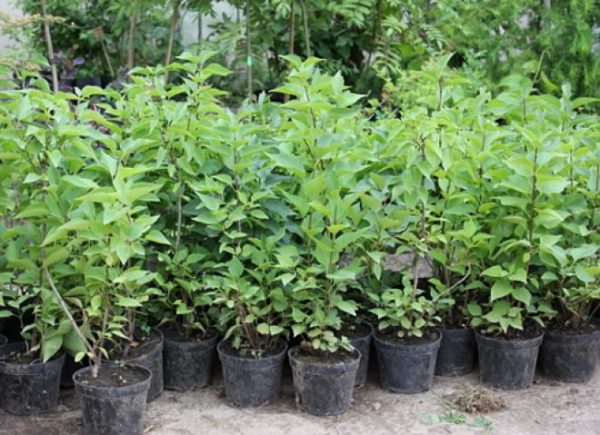 According to the botanical description, lilac is a deciduous shrub reaching a height of 5-8 m. The genus has 30 species and more than 2300 varieties. Gardeners appreciate the plant for large, fragrant inflorescences. Bushes can be grown both on rootstocks and without them. Own crops grow well in temperate climates of the central regions of Russia. Caring for such plants is easier. They are more durable and stronger, do not degenerate into wild form, and quickly recover after freezing.
According to the botanical description, lilac is a deciduous shrub reaching a height of 5-8 m. The genus has 30 species and more than 2300 varieties. Gardeners appreciate the plant for large, fragrant inflorescences. Bushes can be grown both on rootstocks and without them. Own crops grow well in temperate climates of the central regions of Russia. Caring for such plants is easier. They are more durable and stronger, do not degenerate into wild form, and quickly recover after freezing.
Bushes with open roots should immediately be planted in a permanent place. Therefore, the time of purchase must be timed to a favorable time for disembarkation. Before purchasing, the seedling is carefully inspected. The roots should be without damage, well branched, and the stems - without signs of disease and pests. It is better to plant seedlings no older than 3 years old, 50-70 cm high. The diameter of the root lobe should be about 30 cm.
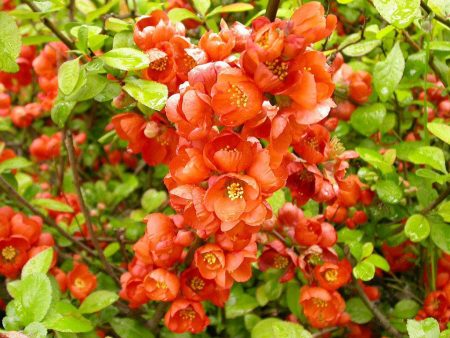 You may be interested in:
You may be interested in:Landing time
The optimal time for planting is the end of summer or the beginning of autumn, when the lilac period begins at rest. Timing depends on climatic conditions. In the central and northern regions, the plant is recommended to be transplanted in late August or early September, and in the southern regions the dates are shifted to early October. You can start planting lilacs in the Moscow Region earlier - in early August. A bush planted on time will have time to take root before the first frosts and will bloom next year.
Seat selection
 Landing in the wrong place will negatively affect the development of the bush. Its growth will be weak, and flowering - sparse. When planting a plant, you should adhere to such recommendations:
Landing in the wrong place will negatively affect the development of the bush. Its growth will be weak, and flowering - sparse. When planting a plant, you should adhere to such recommendations:
- Lilacs do not fit a shady place. It is better to plant it where sunlight is present all day.
- The soil should be nutritious, with neutral acidity. If necessary, it is calcified with dolomite flour, fluff or ash. You should not plant lilacs on sandy and clay soils.
- The shrub does not tolerate the increased humidity that is characteristic of the lowland. It will not grow in a wetland. Therefore, lilac should be planted on flat terrain, providing good drainage.
- To plant a seedling, you need to choose a place protected from gusty winds: near the hedge or near the house.
- Groundwater should be located at a depth of not less than 1.5 m.
Landing Features
 In order for the lilac bush to develop normally, it needs to be given a place with a radius of 2-3 m. If the bushes are placed at a distance of 1 m from each other, a hedge will be obtained. They dig a planting hole so deep that a root ball fits in it.The less fertile the soil, the deeper the pit must be in order to fit more organics. For nutrient soil, the size is 50x50 cm, and for poor soil - 100x100 cm. As a drainage, a layer of broken brick is poured onto the bottom. 30 g of superphosphate, 200 g of wood ash, rotted manure or compost at the rate of 15-20 kg per 1 bush are mixed into the ground.
In order for the lilac bush to develop normally, it needs to be given a place with a radius of 2-3 m. If the bushes are placed at a distance of 1 m from each other, a hedge will be obtained. They dig a planting hole so deep that a root ball fits in it.The less fertile the soil, the deeper the pit must be in order to fit more organics. For nutrient soil, the size is 50x50 cm, and for poor soil - 100x100 cm. As a drainage, a layer of broken brick is poured onto the bottom. 30 g of superphosphate, 200 g of wood ash, rotted manure or compost at the rate of 15-20 kg per 1 bush are mixed into the ground.
Before planting soot into the ground, prepare:
- The roots should be pale green on the cut, flexible. The non-living root easily breaks and is dark inside. Dry areas should be removed.
- The roots are shortened, leaving a length of 30 cm.
- All dry or broken branches are cut from the bush.
- 2-3 hours before planting, the seedling is immersed in warm water so that the roots are saturated with moisture.
- The plant will take root more quickly if the root system is soaked in a biostimulant solution.
Technology planting lilacs includes the following rules:
- A small mound is built in the center of the pit and a peg is installed.
- The seedling is placed on a dais, spreading its roots. The support is placed at a distance of 5-6 cm from the stem.
- Lilacs are covered with nutritious soil, slightly compacting each layer. The root neck should be at ground level. If the plant is grown on a stock, then the vaccine is placed 2-3 cm above the surface of the soil. Such a measure will help to avoid the germination of excess growth.
- If you need to propagate the plant, the root neck is buried in the ground so that overgrowth appears in spring. It will serve as a full planting material.
- Around the planted lilacs make a hole that will prevent the spreading of water. 5 l of liquid is enough for one bush.
What to plant lilac with
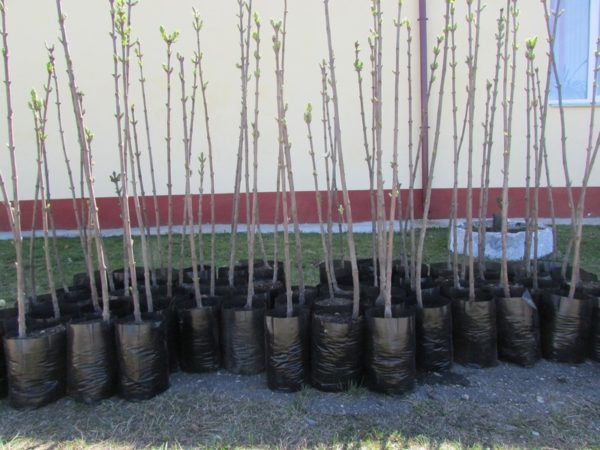 Lilac - a beautiful flowering shrub that looks good in a single planting. A pair of seedlings over several years can form dense thickets. The flowering period of the plant is short. Therefore, it is better to plant it near perennials or other ornamental shrubs that differ in flowering time. Lilac goes well with such garden crops:
Lilac - a beautiful flowering shrub that looks good in a single planting. A pair of seedlings over several years can form dense thickets. The flowering period of the plant is short. Therefore, it is better to plant it near perennials or other ornamental shrubs that differ in flowering time. Lilac goes well with such garden crops:
- mock-up;
- decorative varieties of maple;
- hydrangea;
- viburnum;
- coniferous shrubs;
- cherry.
 You may be interested in:
You may be interested in:After landing care
Lilac is an unpretentious culture that easily adapts to different climatic conditions. However, only with proper care will the bush be lush and flowering. During a lilac transplant in the fall, the pericarpus is mulched with dry leaves, sawdust or peat. The layer thickness should be at least 30 cm. In the spring, the covering material is removed so that the ground can warm up.
Watering and feeding
 If nitrogen-phosphorus fertilizers were added to the planting pit, the bushes are fed from the second season, and if organic matter - after 4 years. A plant solution of wood ash is useful, prepared at the rate of 200-300 g per 10 liters of water. Every 2 years, potassium-phosphorus fertilizers are added under the lilac. Spend such top dressing in the summer. 35 g of potassium nitrate and superphosphate are embedded in the soil. In the spring, when the snow melts, the bush is fed with nitrogen fertilizer. For each bush, spend 50 g of urea.
If nitrogen-phosphorus fertilizers were added to the planting pit, the bushes are fed from the second season, and if organic matter - after 4 years. A plant solution of wood ash is useful, prepared at the rate of 200-300 g per 10 liters of water. Every 2 years, potassium-phosphorus fertilizers are added under the lilac. Spend such top dressing in the summer. 35 g of potassium nitrate and superphosphate are embedded in the soil. In the spring, when the snow melts, the bush is fed with nitrogen fertilizer. For each bush, spend 50 g of urea.
During the period of active growth and blooming of flowers, a young plant needs abundant watering. But do not pour too much water, because its excess will only harm the roots. The day after watering, the soil is loosened to a depth of 5-8 cm. In summer, the seedling is shaded from scorching sunlight. Weeds are regularly weeded so that they do not take away nutrients from the plant.
Bush pruning
In the garden you can see lilacs in the form of a bush or tree. To form a magnificent crown, you need to shorten the main shoot and cut branches, leaving 8-10 the strongest. To grow a tree, buds are cut from the trunk below the level of 50-70 cm. On the main shoot, 5-6 top pairs should remain. Then 1 of the paired shoots is removed. Without regular pruning, in a few years the ornamental shrub will turn into chaotic thickets. Therefore, you need to remove the branches growing inside the bush and thickening the crown.
Sanitary and thinning pruning is carried out in early spring. If necessary, the procedure can be repeated in the summer. In order for the inflorescences to be lush, buds with buds need to be partially trimmed. Faded panicles must be removed immediately, as buds are laid on summer shoots. If such an event is postponed until the fall or not at all, the bush will not bloom next season.
When to plant lilac
Lilacs can be planted at any time of the year when it is warm outside. A bush growing in a container is replanted even in the summer. The procedure is best done from mid-July to early September, when the heat subsides. A plant with an open root system is planted in autumn or spring. If the bush has already begun to lose leaves, planting is better to transfer to spring. Otherwise, he will not have time to fully take root before the autumn frosts. Spring planting begins as early as possible, before the start of sap flow. The pit should be prepared in the fall, as working with frozen ground is more difficult. Before planting lilacs, flower buds must be removed and the heteroauxin roots treated.
Lilac - a garden plant that looks gorgeous even with minimal care. She perfectly survives even in harsh climates. However, to get a truly luxurious flowering, you need to properly plant a lilac bush, regularly take care of it. If cut buds are put in water, they will decorate the room for a long time, spreading a wonderful aroma over it.

